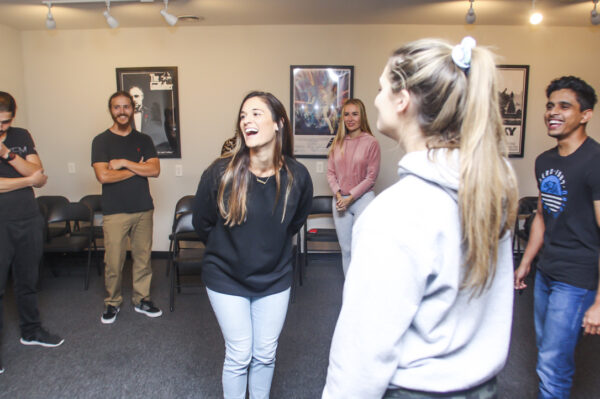
What are We Doing?
The third question in our Formula of Improv brings us to the most widely discussed fundamental in improv—game. At its most basic, game is the fun thing we’re doing in the scene. It is also the thing we bear hug, pattern around, and heighten. Game is the core of our improv scenes.
Finding the Game
We find the game of the scene by asking ourselves “what is the very first weird or unusual thing to happen in this scene?” We most often identify that weird or unusual thing by calling it out, communicating to our scene partner and the audience that this thing—be it an odd reaction, an unexpected location, or a strange item—does not belong in the world we’ve created for this scene. The best part about finding the game is that we get to decide what’s weird or unusual in our scenes! Identifying the game will often indicate which side of the straight/absurd dynamic our character will land on for that scene. If we identify something usually regarded as normal as unusual, our character will likely be absurd. If, on the other hand, we call out something that is obviously weird, we are likely to be the straight character (or the voice of reason) in the scene. As with most improv “rules”, there are always exceptions, but having an understanding of the most likely scenario can help us feel calm and confident in our scenes, thereby making it easier for us to play the game.
Playing the Game
An excellent teacher of mine, James Hamilton, explained it this way: “Game is what we’re doing, pattern is how we’re doing it.” That is to say, once we’ve identified the game and communicated that decision to our scene partners and our audience, we want to play with that game. We do that by finding a way to continue or replicate that weird or unusual thing in new situations, using patterns. Generally, we call this heightening (we’ll talk about heightening in more detail in a future blog). We may find that as we offer the absurd character different things, they are playing the game by filtering those offers through their character’s unusual perspective. We may find that as we move through the world we’re creating, we’re finding odder and odder things, causing our characters’ to play the game by having more intense emotional reactions. There are as many ways to play the game as there are games to play in an improv scene. The key is learning to identify (or choose) the game and play it using a recognizable pattern so that our scene partners and audience can follow, even if the audience is a half-step behind.
The game of an improv scene has been the focus of an infinite number of discussions, workshops, classes, and blogs. It can be very convoluted and misunderstood, but all it really is is the thing we’re doing to make ourselves, our scene partners, and the audience laugh. The game is the fun, and we are all merely players, to paraphrase an old British dude. Now go play!
